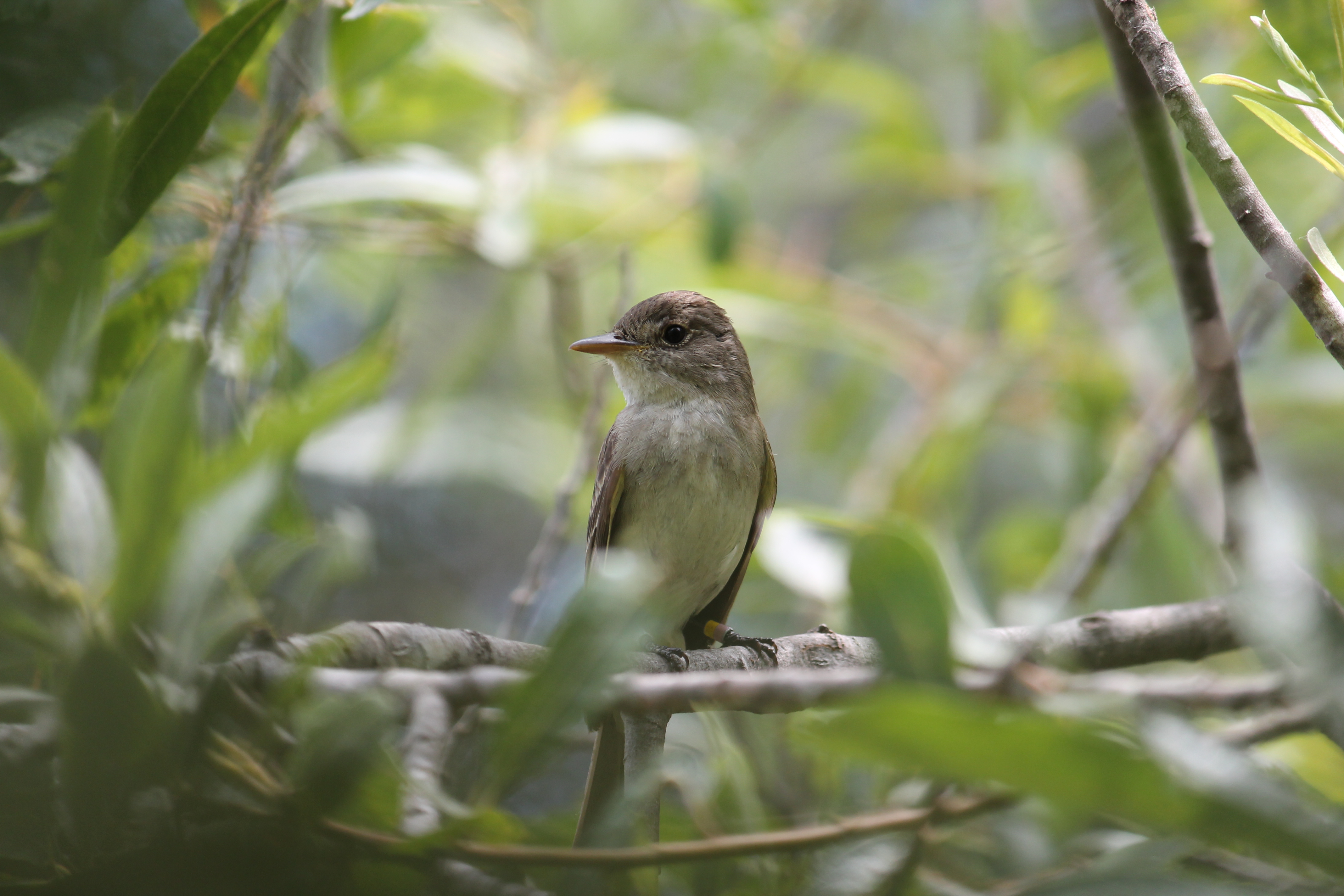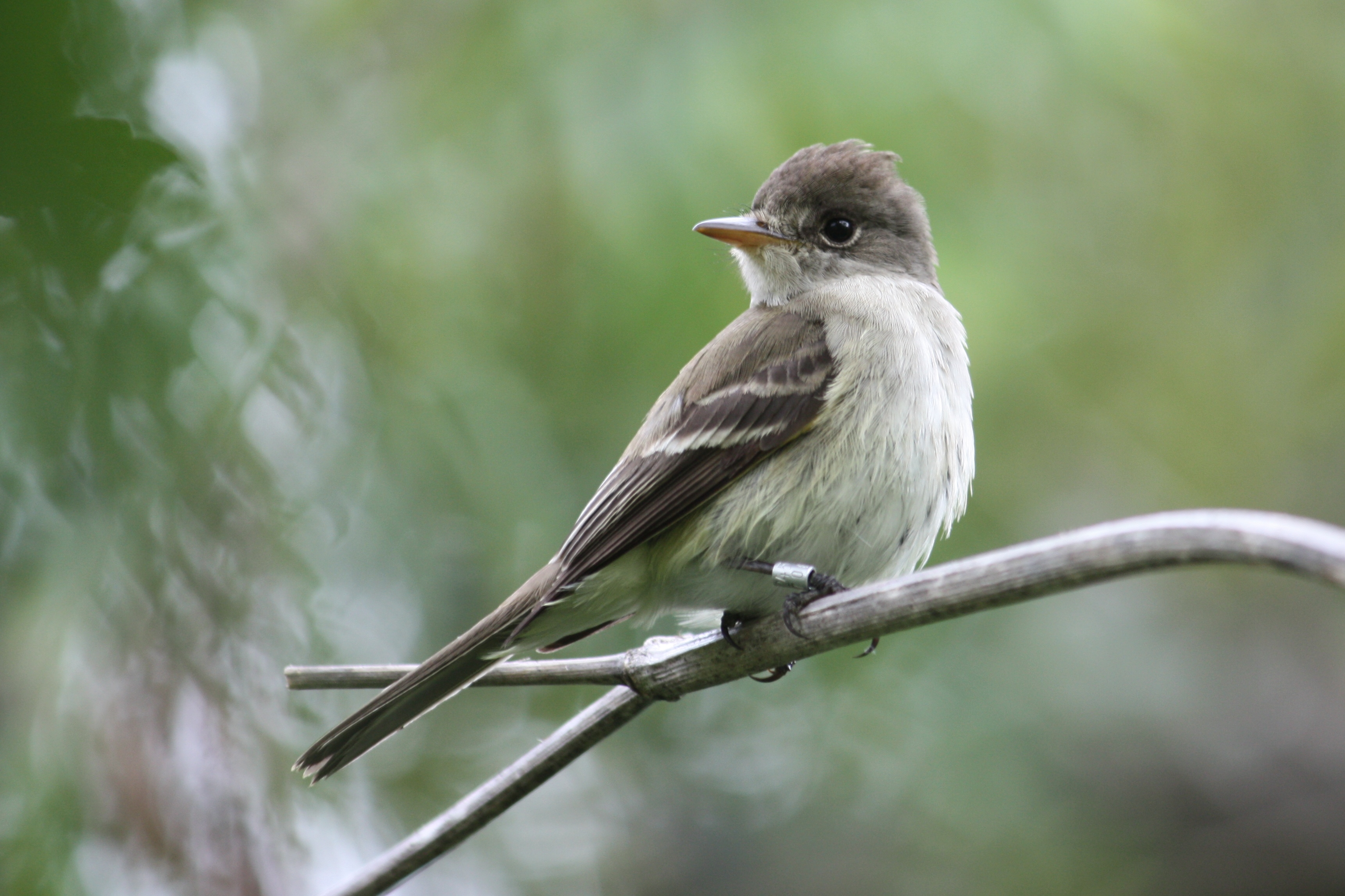Current Distribution Rangewide
Breeding range: southern California, Arizona, New Mexico, southern Nevada and Utah, western Texas, southwestern Colorado, and possibly northern portions of the Mexican states of Baja California, Sonora and Chihuahua [1]. Winters in southern Mexico, Central America, and northern South America (references in USFWS 2002). River systems where the flycatcher persists in California include the Colorado, Owens, Kern, Mojave, Santa Ana, Pilgrim Creek, Santa Margarita, San Luis Rey, San Diego, San Mateo Creek, San Timoteo Creek, Santa Clara, Santa Ynez, Sweetwater, San Dieguito, and Temecula Creek (see references in USFWS 2002). Common tree and shrub species that comprise nesting habitat include willows (Salix spp.), seepwillow (aka mulefat; Baccharis spp.), boxelder (Acer negundo), stinging nettle (Urtica spp.), blackberry (Rubus spp.), cottonwood (Populus spp.), arrowweed (Tessaria sericea), tamarisk (aka saltcedar; Tamarix ramosissima), and Russian olive (Eleagnus angustifolia) (see references in USFWS 2002).
List Status
FE, SE
Habitat Affinities
Breeds in relatively dense riparian tree and shrub communities associated with rivers, swamps, and other wetlands, including lakes/reservoirs; most are classified as forested wetlands or scrub-shrub wetlands [1]. Breeds from near sea level to >2,600 m (8,500’) but primarily in lower-elevation areas [1]. Appendix G in USFWS (2002) has extensive description of habitat associations. E. t. extimus almost always nests near surface water or saturated soil (references in USFWS 2002). In some cases a site may dry out, but riparian vegetation and nesting flycatchers may persist 1-2 breeding seasons before they are eventually lost. Often cluster territories into small portions of riparian sites; major portions of site may be occupied irregularly or not at all (references in USFWS 2002).
Taxonomy and Genetics
Four subspecies separated in breeding ranges & distinguished primarily by subtle differences in color and morphology [2]. Paxton (2000 in USFWS 2002) concluded E. t. extimus is genetically distinct from other willow flycatcher subspecies. Recent research found substantial genetic variation within and among flycatcher breeding groups, and within and between watersheds (references in USFWS 2002).
Seasonal Activity
Range-wide, typically arrive on breeding grounds early May to early June; a few may establish territories in very late April (references. in USFWS 2002). Typical arrival first week of May in southern California and Arizona [2]. Males usually arrive first at breeding site and establish territory [1]. Females tend to arrive ~1-2 weeks later.
Life History/Reproduction
Typical clutch size 3-4 eggs; 12-13 d incubation [1,3]. Second nest attempts after successful fledging of first nest are rare; mostly occur if young fledge by late June or early July. Female may attempt up to 4 nests in a season if attempts lost to predation, parasitism, or disturbance (Smith et al. 2002 in USFWS 2002). Fecundity reduced by factors such as nest predation and brood parasitism by brown-headed cowbird (Molothrus ater). Recovery Plan [1] estimated ~900-1100 pairs range-wide. Another estimate based on 1993-1996 surveys was 549 territories with a minimum of 70% documented as confirmed or probable breeding pairs [4]. Breeding behavior must be confirmed to conclude an observation of willow flycatcher is E. t. extimus since migrating flycatchers in San Diego County may be E. t. brewsteri [2]. E. t. brewsteri breeding range extends from central California coast north, through western Oregon and Washington to Vancouver Island.
Diet and Foraging
Insectivorous. Captures prey on the wing or by gleaning in and above dense riparian vegetation (referemces. in USFWS 1993). Also forages in areas adjacent to nest sites which may be more open [6]. Diet studies [7] indicate a wide range of prey consumed. Major prey ranged from small (flying ants) to large (dragonflies) flying insects; Hymenoptera, Diptera and Hemiptera comprised half of prey items.
Dispersal
Fledglings typically stay in nest area minimum 14-15 d after fledging, possibly much longer [1]. One action identified in Recovery Plan is “survey to determine dispersal movements and colonization events.†Multi-year studies of color-banded birds showed although most returned to former breeding areas, flycatchers regularly moved among sites within and between years (references in USFWS 2002). In one 3-year study 66%-78% of flycatchers known to have survived from one breeding season to the next returned to the same breeding site; 22% -34% of returning birds moved to different sites (Luff et al. 2000 in USFWS 2002).
Threats
Threats/limiting factors include extensive loss and modification of breeding habitat and threat of increased brood parasitism by cowbirds [1]. Riparian decline caused mainly by: reduction or elimination of surface and subsurface water from diversion and groundwater pumping; changes in flood and fire regimes from dams and stream channelization; clearing and controlling vegetation; livestock grazing; changes in water and soil chemistry due to disruption of natural hydrologic cycles; and invasive non-native plants.
Special Considerations:
For a thorough review of the influence of cowbird parasitism, including recommendations on when management actions are warranted, consult Appendix F in Recovery Plan [2]. Of the states where this sub-species breeds, parasitism by brown-headed cowbirds has the greatest impact in California; the largest population in California consistently experienced rates of at least 50% in the absence of cowbird control [1]. The Recovery Plan notes that it is important to consider that the presence of cowbird parasitism does not necessarily mean it is having significant effects on a given flycatcher population. The Recovery Plan identifies multiple specific actions in the following nine areas to promote increased populations: (1) increase and improve currently suitable and potentially suitable habitat; (2) increase metapopulation stability; (3) improve demographic parameters; (4) minimize threats to wintering and migration habitat; (5) survey and monitor; (6) conduct research; (7) provide public education and outreach; (8) assure implementation of laws, policies, and agreements that benefit the flycatcher; (9) track recovery progress. Overuse by livestock has been a major factor in the degradation and modification of riparian habitats in the western U.S., with effects including changes in plant community structure, species composition, and relative abundance of species and plant density [6]. Invasion by tamarisk (Tamarix sp.) and giant reed (Arundo donax) have also altered native riparian communities.
Literature Sources
[1] U.S. Fish and Wildlife Service. 2002. Final Recovery Plan Southwestern Willow Flycatcher (Empidonax traillii extimus). Prepared by Southwestern Willow Flycatcher Recovery Team Technical Subgroup. Prepared for Region 2 U.S. Fish and Wildlife Service, Albuquerque, New Mexico 87103. August 2002. 210 pp., Appendices A-O.
[2] Unitt, P. 1987. Empidonax traillii extimus; An endangered subspecies. Western Birds 18:137-162.
[3] Sedgwick, J. A. 2000. Willow flycatcher Empidonax traillii. No. 533. In The Birds of North America. A. Poole and F. Gill, Eds. Cornell Laboratory of Ornithology, N.Y. and The Academy of Natural Sciences, Washington D. C.
[4] Marshall, R.M. 2000. Chapter 2: Population status on breeding grounds, pp.3-11 In Finch, D. M. and S. H. Stoleson, eds. 2000. Status, ecology, and conservation of the southwestern willow flycatcher. Gen. Tech. Rep. RMRS-GTR-60. Ogden, UT: U.S. Department of Agriculture, forest Service, Rocky Mountain Research Station. 131 pp.
[5] U.S. Fish and Wildlife Service. 1993. Endangered and Threatened Wildlife and Plants; Proposed Rule to List the Southwestern Willow Flycatcher as Endangered with Critical Habitat. Federal Register 58:39495-39522.
[6] U.S. Fish and Wildlife Service. 1995. Endangered and Threatened Wildlife and Plants; Final Rule Determining Endangered Status for the Southwestern Willow Flycatcher. Federal Register 60:10693-10715.
[7] Drost, C.A., E. H. Paxton, M. K. Sogge, and M. J. Whitfield. 2001. Food Habits of the Endangered Southwestern Willow Flycatcher. Final Report to the U.S. Bureau of Reclamation, Salt Lake City January 2001.

